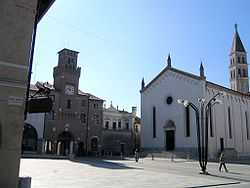Oderzo
| Oderzo | ||
|---|---|---|
| Comune | ||
| Comune di Oderzo | ||
 | ||
| ||
 Oderzo | ||
| Coordinates: 45°46′48″N 12°29′17″E / 45.78000°N 12.48806°E | ||
| Country | Italy | |
| Region | Veneto | |
| Province | Treviso (TV) | |
| Frazioni | Camino, Colfrancui, Faè, Fratta, Rustignè, Piavon | |
| Government | ||
| • Mayor | Pietro Dalla Libera | |
| Area | ||
| • Total | 42 km2 (16 sq mi) | |
| Elevation | 14 m (46 ft) | |
| Population (30 January 2012)[1] | ||
| • Total | 20,361 | |
| • Density | 480/km2 (1,300/sq mi) | |
| Demonym | Opitergini | |
| Time zone | CET (UTC+1) | |
| • Summer (DST) | CEST (UTC+2) | |
| Postal code | 31046 | |
| Dialing code | 0422 | |
| Patron saint | San Tiziano | |
| Saint day | 16 January | |
| Website | Official website | |
Oderzo (Latin: Opitergium) is a town and comune in the province of Treviso, Veneto, northern Italy. It lies in the heart of the Venetian plain, about 66 kilometres (41 miles) to the northeast of Venice. Oderzo is traversed by the Monticano River, a tributary of the Livenza.
The centro storico, or town center, is rich with archeological ruins which give insight into Oderzo's history as a notable crossroad in the Roman Empire.
Political division
The six suburbs or frazioni which surround Oderzo almost in the form of a hexagon. Starting from the north and then proceeding clockwise, they are:
|
|
History
Venetic period
The earliest settlement of the area can be dated to the Iron Age, around the 10th century BC. From the mid-9th century BC the Veneti occupied site and gave it its name. Etymologically, "-terg-" in Opitergium stems from a Venetic root word indicating a market (q.v. Tergeste, the old name of Trieste). The location of Oderzo on the Venetian plain made it ideal as a center for trade.

Romanization
The Veneti of Oderzo appear to have maintained friendly relations with the Romans and the population was gradually Romanized. The Via Postumia road, finished in 148 BC, increased the importance of Oderzo.
During the Roman Civil War, Caius Volteius Capito, a centurion born in Oderzo, fought on the side of Julius Caesar against Pompey.
In 48 BC the city was elevated to the rank of Roman municipium and its citizens assigned to the Roman tribe Papiria. With the reforms of Augustus Oderzo was incorporated into Regio X of Italia, Venetia et Histria. The Roman era witnessed prodigious building projects including a forum, a basilica, temples and many private homes.
Middle Ages
During the barbarian invasions, Oderzo was sacked by the Marcomanni (167); nearly three centuries later, according to a local legend, Attila hid a treasure in a town's pit. Under the Byzantine Empire, it became the seat of an exarch and was held by the Byzantines until its destruction by the Lombard king Grimoald in 667. Much of its population fled to the nearby city of Heraclea, still under Byzantine control. Most of its territory passed to the Count of Ceneda.
According to tradition, the first Doge of Venice, Paolo Lucio Anafesto, came from Oderzo. The town, which had grown again around a castel from c. 1000, was contended between the bishops of Belluno and Ceneda, the comune of Treviso and the feudal da Camino (originary of the Camino castle, now part of Oderzo) and da Romano families until, in 1380, it became a stable possession of the Republic of Venice.
Modern era
Oderzo was annexed to the Kingdom of Italy in 1866. In 1917, during World War I, the town was damaged in the aftermath of the Italian rout at Caporetto.
In 1943 it was a centre of the civil war between the German puppet Republic of Salò (RSI) and the partisan resistance. In 1945, 120 people suspected of allegiance to the RSI were executed (see Oderzo Massacre).
The city was governed by the Italian Christian Democratic party from 1945–1993, and lived a notable economic boom, which also attracted a massive immigration from the southern Italy regions.
The Ciclocross del Ponte Faè di Oderzo is a cyclo-cross race held in December.
Main sights
- The Piazza Grande
- The Duomo (Cathedral) of St. John the Baptist, begun in the 11th century over the ruins of the Roman temple of Mars, and re-consecrated in 1535. The original Gothic-Romanesque appearance has been modified by the subsequent renovations. It includes some notable works by Pomponio Amalteo.
- Archaeological area of the Roman Forum. It includes the remains of the basilica and a wide staircase.
- Torresin (watchtower)
- The Renaissance Palazzo Porcia e Brugnera.
- The former Prisons (Porta Pretoria). It includes the remains of a Middle Ages prison, whose most famous guest was the trobadour Sordello da Goito.
In the frazione of Colfrancui is the mysterious Mutera, an artificial hill of the Adriatic Veneti, probably used as an observatory.
International relations
Oderzo is twinned with:
 Pontremoli, Italy
Pontremoli, Italy Suffolk, United States
Suffolk, United States
| Wikimedia Commons has media related to Oderzo. |
References
- ↑ Population data from Istat
Sources
- Brisotto, G.B. (1999). Guida di Oderzo.
